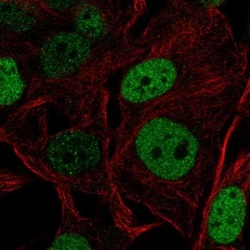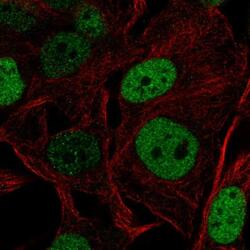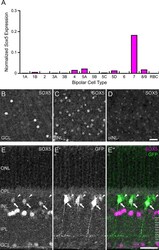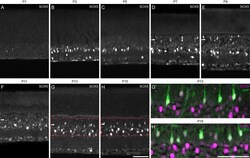Antibody data
- Antibody Data
- Antigen structure
- References [1]
- Comments [0]
- Validations
- Immunocytochemistry [2]
- Other assay [2]
Submit
Validation data
Reference
Comment
Report error
- Product number
- PA5-66331 - Provider product page

- Provider
- Invitrogen Antibodies
- Product name
- SOX5 Polyclonal Antibody
- Antibody type
- Polyclonal
- Antigen
- Recombinant protein fragment
- Description
- Immunogen sequence: VEEEESDGLPA FHLPLHVSFP NKPHSEEFQP VSLLTQETCG HRTPTSQHNT MEVDGNKVMS SFAPHNSSTS PQKAEEGGRQ SGESLSSTAL G Highest antigen sequence identity to the following orthologs - mouse 91%, rat 88%.
- Reactivity
- Human
- Host
- Rabbit
- Isotype
- IgG
- Vial size
- 100 µL
- Concentration
- 0.08 mg/mL
- Storage
- Store at 4°C short term. For long term storage, store at -20°C, avoiding freeze/thaw cycles.
Submitted references Contraction of axonal and dendritic fields in Sox5-deficient cone bipolar cells is accompanied by axonal sprouting and dendritic hyper-innervation of pedicles.
Kulesh B, Reese BE, Keeley PW
Frontiers in neuroanatomy 2022;16:944706
Frontiers in neuroanatomy 2022;16:944706
No comments: Submit comment
Supportive validation
- Submitted by
- Invitrogen Antibodies (provider)
- Main image

- Experimental details
- Immunofluorescent staining of SOX5 in human cell line SK-MEL-30 shows localization to nucleoplasm. Samples were probed using a SOX5 Polyclonal Antibody (Product # PA5-66331).
- Submitted by
- Invitrogen Antibodies (provider)
- Main image

- Experimental details
- Immunofluorescent staining of SOX5 in human cell line SK-MEL-30 shows localization to nucleoplasm. Samples were probed using a SOX5 Polyclonal Antibody (Product # PA5-66331).
Supportive validation
- Submitted by
- Invitrogen Antibodies (provider)
- Main image

- Experimental details
- Figure 1 (A) Single cell transcriptional profiling of retinal bipolar cells demonstrated that Sox5 expression is near-selectively expressed in only one the Type CBC, the Type 7 CBC (from Shekhar et al., ; accessed from the single cell portal from the Broad Institute: https://singlecell.broadinstitute.org/single_cell ). For each cell, the number of transcripts for each gene was adjusted to account for sequencing depth, and then log transformed, ln(x + 1), as described in Shekhar et al. (). Each histogram plots the average of this normalized expression across all cells for each bipolar cell type. (B-D) Immunostaining of mature mouse retinal wholemounts using an antibody to SOX5 reveals labeled cells in the GCL (B) and in the INL, the latter including cells in the innermost portion (iINL), being the amacrine cell layer (C) , as well as cells in the outermost portion (oINL), being the bipolar cell stratum (D) . (E-E") Immunostaining Gustducin-gfp transgenic retinas for SOX5 (E-E") confirms that the SOX5-positive cells in the bipolar cell stratum are also GFP+ ( E' , arrows). These are confirmed to be Type 7 CBCs by virtue of their stratifying axonal arbors in S4 of the IPL. Note three GFP-positive cells that do not co-localize SOX5 in their somata (arrowheads in E-E" ); these are RBCs, evidenced by their dimmer GFP fluorescence and by their axons reaching into S5 of the IPL. Calibration bars = 50 mum.
- Submitted by
- Invitrogen Antibodies (provider)
- Main image

- Experimental details
- Figure 2 (A-H) Developmental time-course of the emergence of SOX5-immunolabeling in the retina, from the day of birth through the first two postnatal weeks. Note the onset of labeling in cells in the emerging bipolar cell stratum at the close of the first postnatal week (D) , remaining thereafter (horizontal arrows). Panels (G',H') show magnified regions of the INL from panels (G) and (H) , confirming that those SOX5-immunopositive cells in the bipolar cell stratum (magenta) are Type 7 CBCs, as they are also GFP-positive (green). Calibration bars = 50 mum.
 Explore
Explore Validate
Validate Learn
Learn Immunocytochemistry
Immunocytochemistry